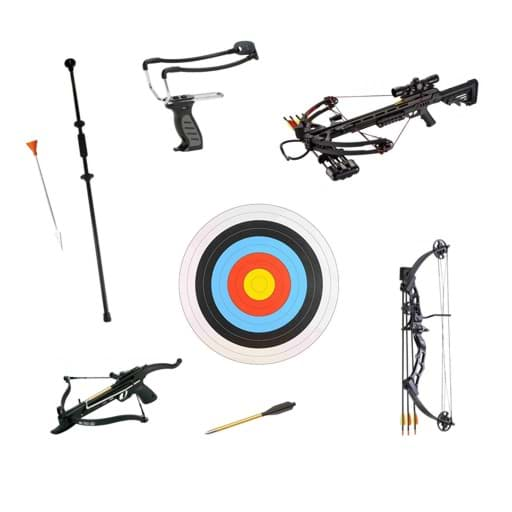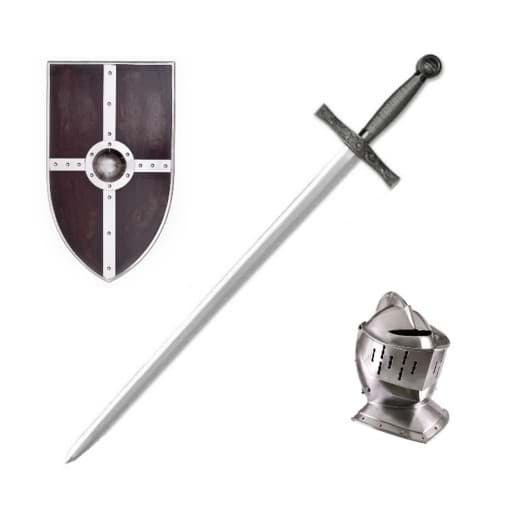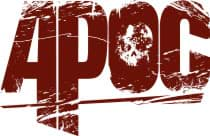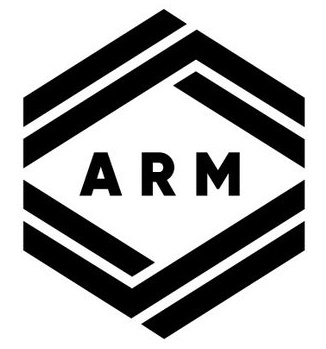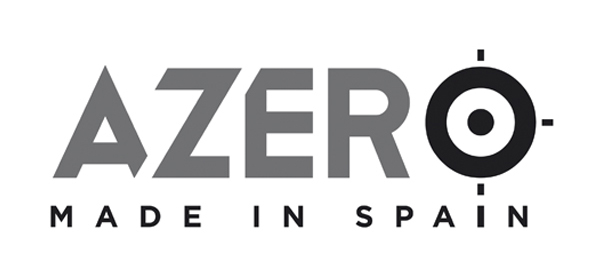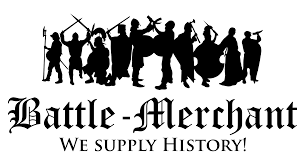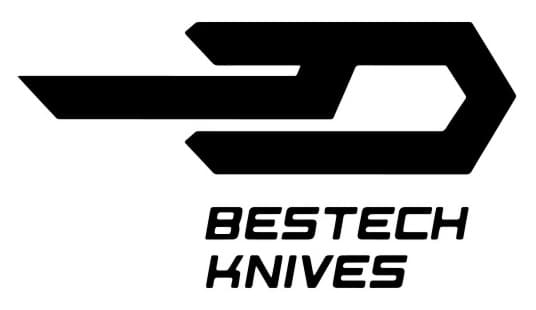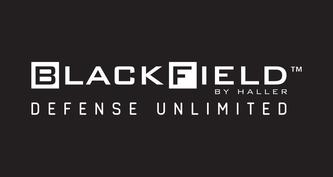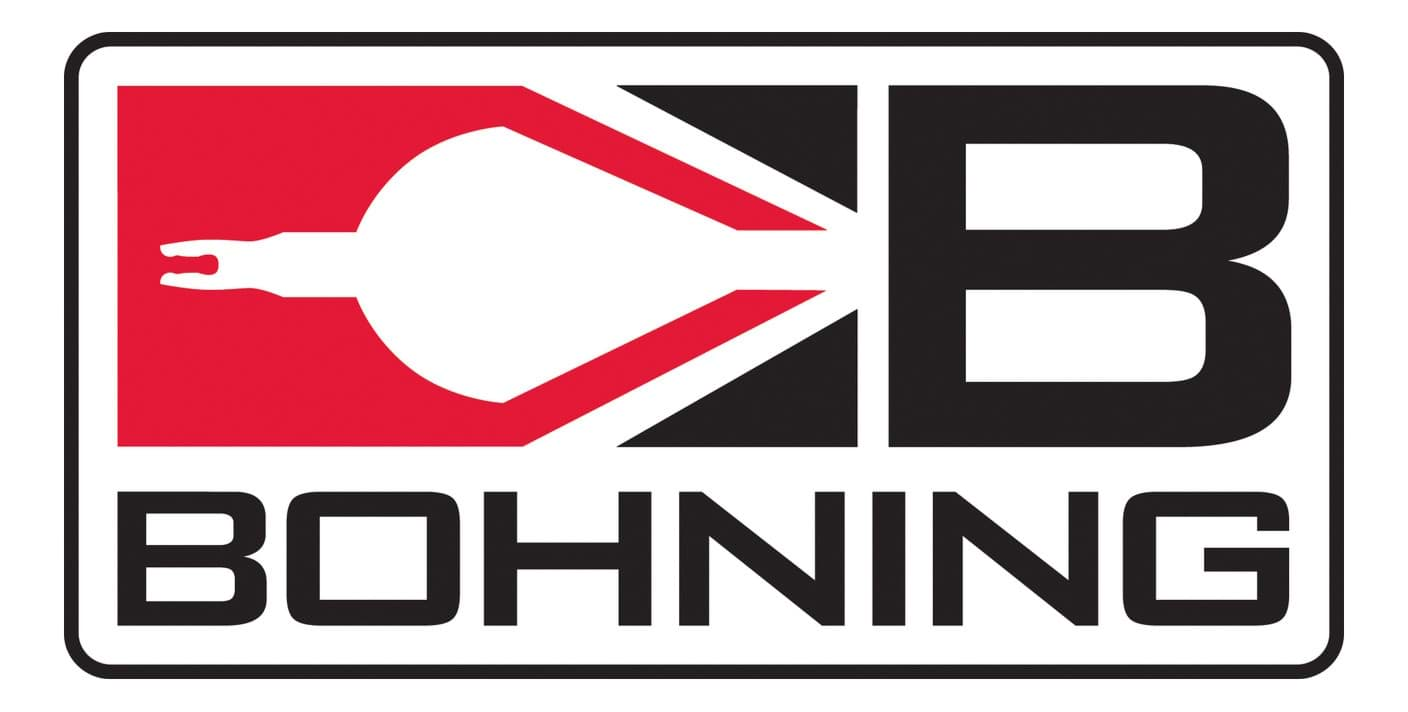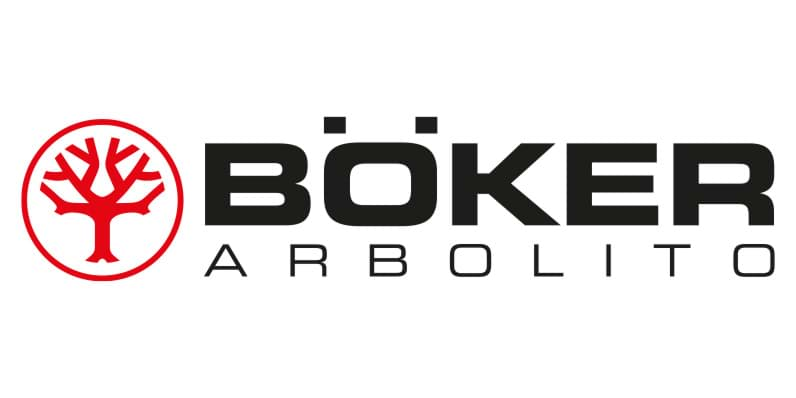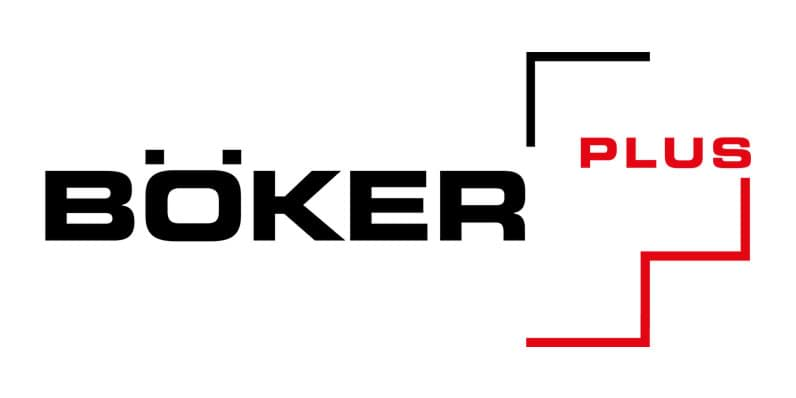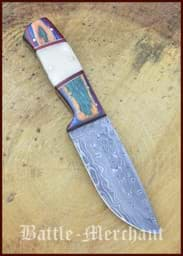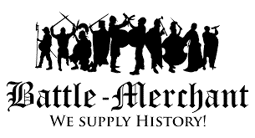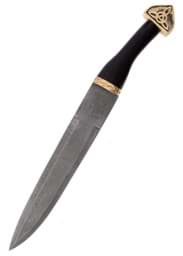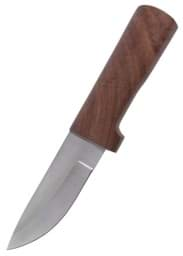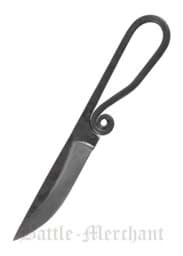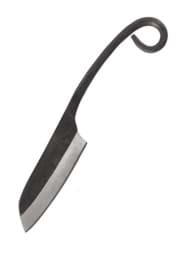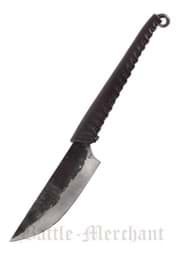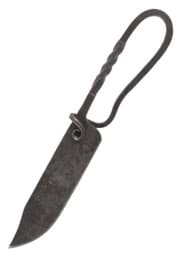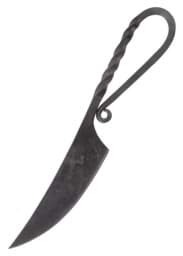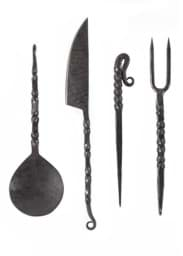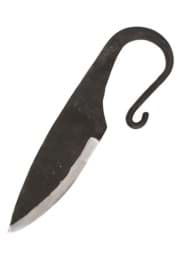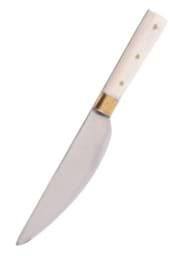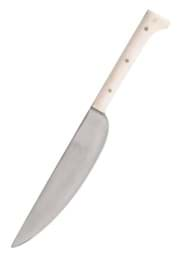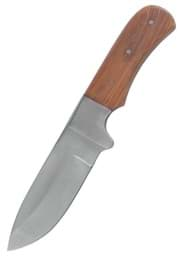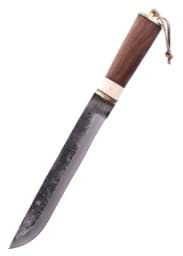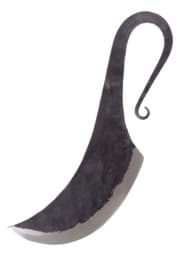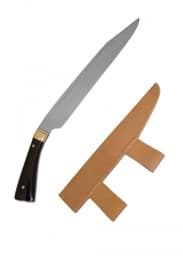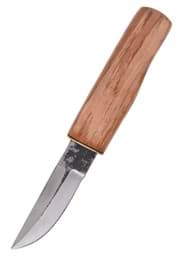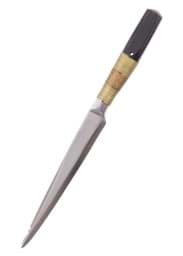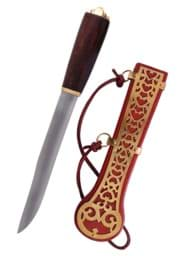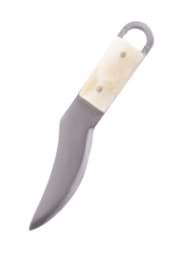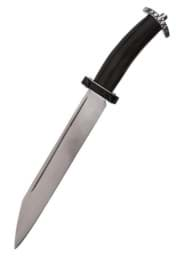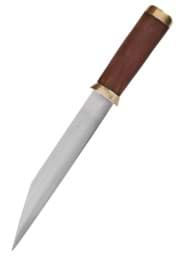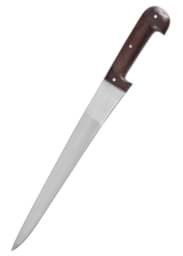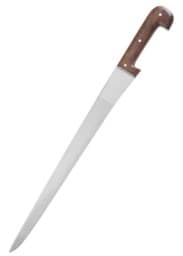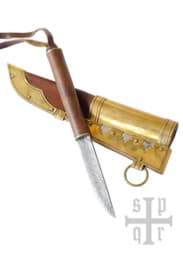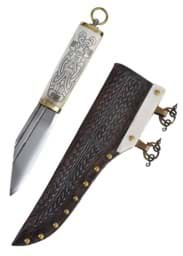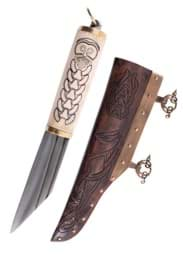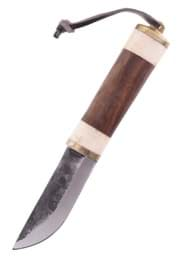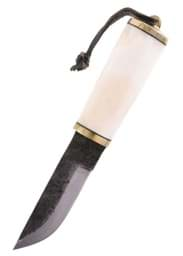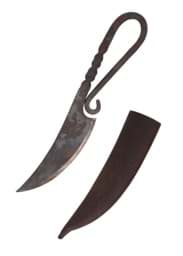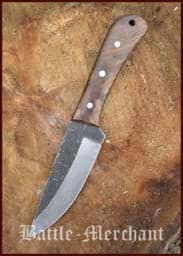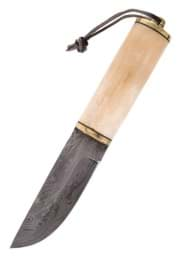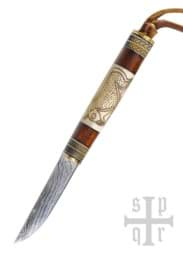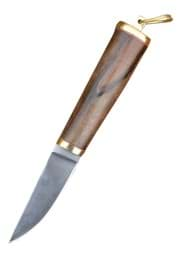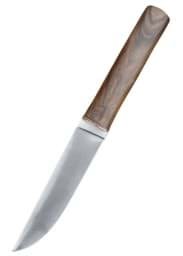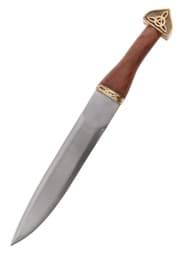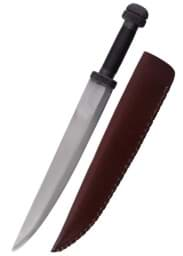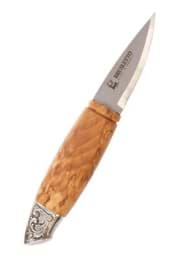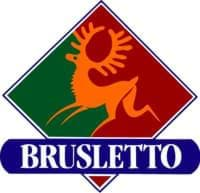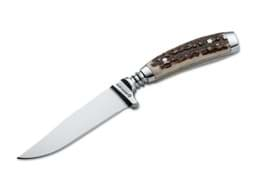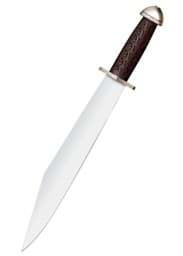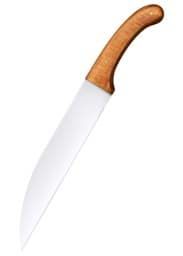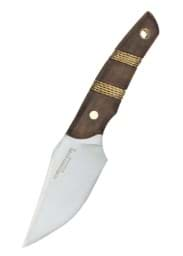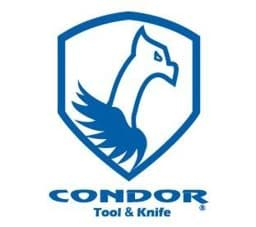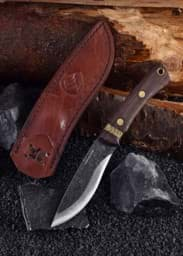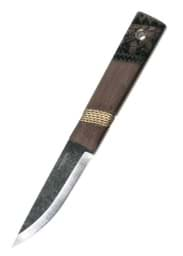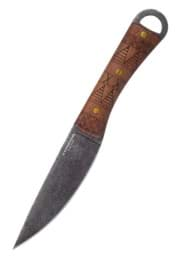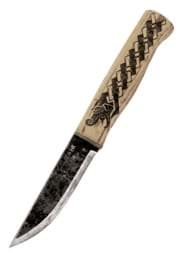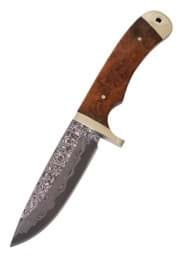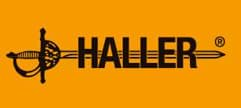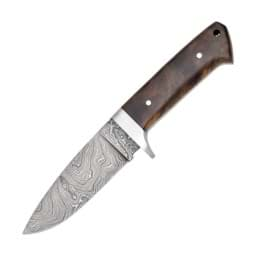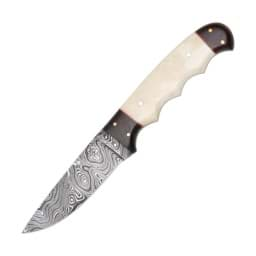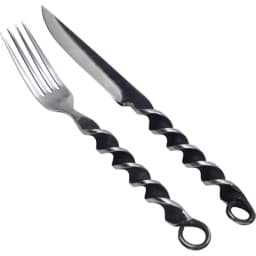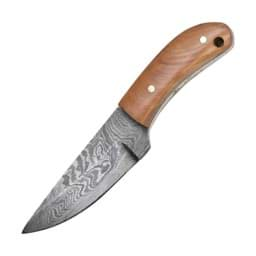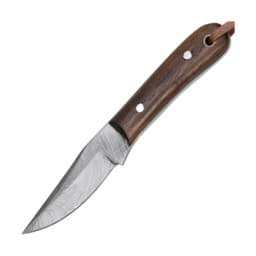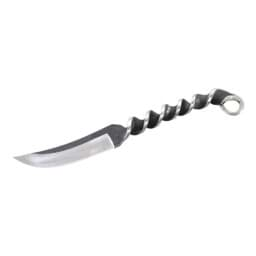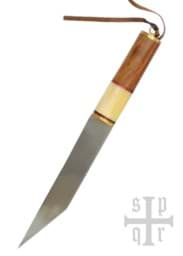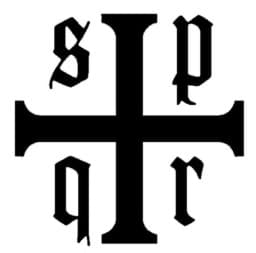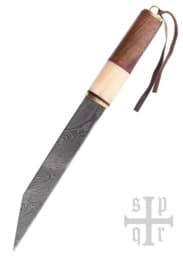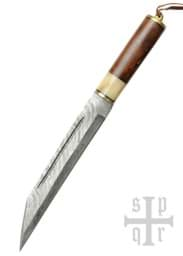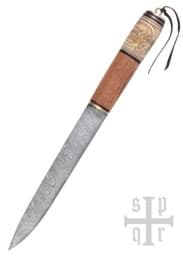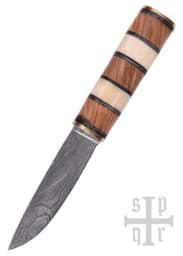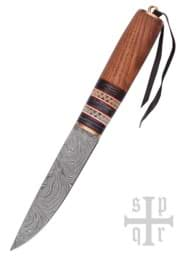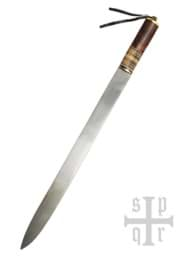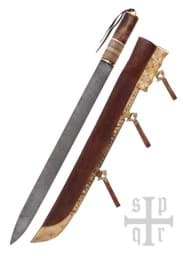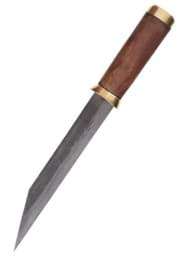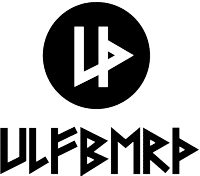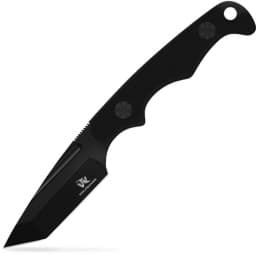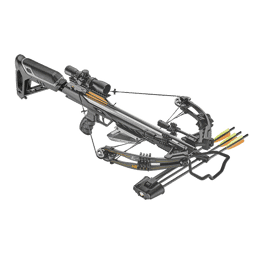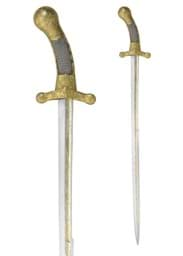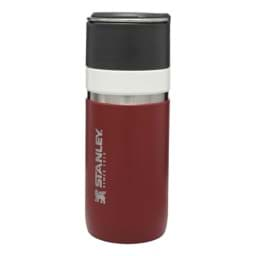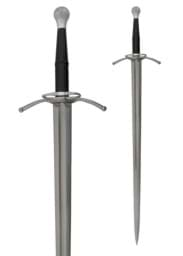Historical Knives
1-66 of 66
Battle Merchant - Damascus Hunting Knife Wood-Bone
Damascus hunting knife with 176176 cm long blade made of 176 layer Damascus steel, handle made of colored wood and bone, and beautiful leather sheath
* Prices incl. VAT, plus shipping
Battle Merchant - Damascus Sax with Horn Handle
Battle Merchant Damascus Sax with Horn Handle ► Total length 47 cm ✓ 31 cm long blade ✓ Leather sheath ✓ Weight 900 g ✓ "buy now in Switzerland!"
* Prices incl. VAT, plus shipping
Battle Merchant - Early Medieval Steel Knife
Battle Merchant Early Medieval Knife made of Steel ► Historic knife ✓ 12 cm long blade ✓ "buy now in Switzerland!"
* Prices incl. VAT, plus shipping
Battle Merchant - Fixed Blade Knife with Wooden Handle and Leather Sheath
Battle Merchant hunting knife with wooden handle and leather sheath ► 11.5 cm long blade ✓ 440 Steel ✓ Leather sheath ✓ "buy now in Switzerland!"
* Prices incl. VAT, plus shipping
Battle Merchant - Forged Knife 440 Steel with Leather Sheath 19 cm
Forged knife made of 440 steel with leather sheath. The forged knife 440 steel with leather sheath 19 cm from Battle Merchant
* Prices incl. VAT, plus shipping
Battle Merchant - Forged Knife Sheepfoot Blade 15 cm
Battle Merchant Forged Knife Sheepfoot Blade 15 cm ► Historic knife ✓ 6.5 cm long blade made of 440er steel ✓ Leather sheath ✓ Buy now!
* Prices incl. VAT, plus shipping
Battle Merchant - Forged Knife with Leather Handle 21 cm
Forged knife with leather handle and leather sheath. The forged knife with leather handle 21 cm from Battle Merchant
* Prices incl. VAT, plus shipping
Battle Merchant - Forged Knife with Leather Sheath 23 cm
Battle Merchant Forged Knife with Leather Sheath approx. 23 cm ► Historic knife ✓ 4402 cm long blade made of 440 steel ✓ Leather sheath ✓
* Prices incl. VAT, plus shipping
Battle Merchant - Forged Medieval Knife 21 cm
Battle Merchant Forged Medieval Knife 21 cm ► Historic knife ✓ 10.5 cm long blade ✓ Leather sheath ✓ "buy now in Switzerland!"
* Prices incl. VAT, plus shipping
Battle Merchant - Forged Medieval Knife with Sheath
Battle Merchant Forged Medieval Knife with Sheath ► Historic knife ✓ 9.5 cm long blade made of 440er steel ✓ Leather sheath ✓
* Prices incl. VAT, plus shipping
Battle Merchant - Forged Skinning Knife
Battle Merchant Forged Furrier Knife ► Historic knife ✓ 9 cm long blade ✓ "buy now in Switzerland!"
* Prices incl. VAT, plus shipping
Battle Merchant - Hand-forged Cutlery Set 4-piece
Battle Merchant Hand-forged Cutlery Set of Four with Leather Pouch ► Cutlery ✓ forged iron ✓ with leather case ✓ Buy now!
* Prices incl. VAT, plus shipping
Battle Merchant - Hand-forged Viking Knife with Leather Sheath
Battle Merchant Hand-Forged Viking Knife with Leather Sheath ► Historic knife ✓ 12.5 cm long blade ✓ Carbon Steel ✓ Leather sheath ✓ Buy now!
* Prices incl. VAT, plus shipping
Battle Merchant - Knife with Brown Leather Sheath 19 cm
Battle Merchant knife with brown leather sheath approx. 19 cm ► Historic knife ✓ 11 cm long blade ✓ Leather sheath ✓ "buy now in Switzerland!"
* Prices incl. VAT, plus shipping
Battle Merchant - Knife with Brown Leather Sheath 23 cm
Battle Merchant knife with brown leather sheath approx. 23 cm ► Historic knife ✓ 14 cm long blade ✓ Leather sheath ✓ "buy now in Switzerland!"
* Prices incl. VAT, plus shipping
Battle Merchant - Knife with Olive Wood Handle
Battle Merchant Knife with Olive Wood Handle ► Bushcraft Knives ✓ 10 cm long blade ✓ 440 steel ✓ Leather sheath ✓ "buy now in Switzerland!"
* Prices incl. VAT, plus shipping
Battle Merchant - Knife with Wooden Handle and Leather Sheath
Battle Merchant knife with wooden handle and leather sheath ► Sax ✓ Total length 43 cm ✓ 27.5 cm long blade ✓ Carbon Steel ✓ Wooden handle with bone inlay ✓
* Prices incl. VAT, plus shipping
Battle Merchant - Large Utility Knife with Leather Sheath
Battle Merchant utility knife large with leather sheath ► Historic knife ✓ 14 cm long blade ✓ Leather sheath ✓ "buy now in Switzerland!"
* Prices incl. VAT, plus shipping
Battle Merchant - Long Sax with Horn Handle 9th Century
Battle Merchant Langsax with Horn Handle 9. century ► Total length 60 cm ✓ 44 cm long blade ✓ Weight 1.35 kg ✓ "buy now in Switzerland!"
* Prices incl. VAT, plus shipping
Battle Merchant - Medieval Knife with Wooden Handle and Leather Sheath
Battle Merchant medieval knife with wooden handle and leather sheath ► Historic knife ✓ 10 cm long blade ✓ Leather sheath ✓ "buy now in Switzerland!"
* Prices incl. VAT, plus shipping
Battle Merchant - Medieval Table Knife with Sheath
Battle Merchant Medieval Table Knife with Sheath ► Historic knife ✓ 13.5 cm long blade ✓ Weight 150g ✓ "buy now in Switzerland!"
* Prices incl. VAT, plus shipping
Battle Merchant - Roman Dura-Europos Dagger, 3rd Century AD
Battle Merchant Roman Dura-Europos Dagger 3. 1 pc. n. Chrome. ► Total length 31.5 cm ✓ 19.5 cm long blade ✓ Spring steel EN45 ✓ Wooden handle ✓ Wooden scabba...
* Prices incl. VAT, plus shipping
Battle Merchant - Roman Utility Knife 13 cm
Battle Merchant Roman Utility Knife 13 cm long ► Historic knife ✓ 8 cm long blade ✓ "buy now in Switzerland!"
* Prices incl. VAT, plus shipping
Battle Merchant - Short Sax with Horn Handle
Battle Merchant short seax with horn handle ► Total length 36 cm ✓ 22.5 cm long blade ✓ Leather sheath ✓ Weight 0.5 kg ✓ "buy now in Switzerland!"
* Prices incl. VAT, plus shipping
Battle Merchant - Simple Sax Knife 31 cm
Battle Merchant Simple Seax Knife 31 cm ► Total length 45 cm ✓ 31 cm long blade ✓ Leather sheath ✓ Weight 500 g ✓ "buy now in Switzerland!"
* Prices incl. VAT, plus shipping
Battle Merchant - Simple Sax Knife 41 cm
Battle Merchant Simple Seax Knife 41 cm ► Total length 54.5 cm ✓ 41 cm long blade ✓ Leather sheath ✓ Weight 550 g ✓ "buy now in Switzerland!"
* Prices incl. VAT, plus shipping
Battle Merchant - Small Viking Knife from Gotland Damascus Steel
Battle Merchant Small Viking Knife made of Gotland Damascus Steel ► 8 cm long blade ✓ Damascus steel 256 layers ✓ Wooden handle and brass ✓ Leather sheath ✓
* Prices incl. VAT, plus shipping
Battle Merchant - Small Viking Seax in Borre Style 9th - 10th Century
Battle Merchant Small Viking Sax in Borre Style 9. 10. 1 pc. ► Sax ✓ Total length 21 cm ✓ 10 cm long blade ✓ Spring steel EN45 ✓ Buy now!
* Prices incl. VAT, plus shipping
Battle Merchant - Small Viking Seax with Bone Handle
Battle Merchant Small Viking Sax with Bone Handle ► 10 cm long blade ✓ Spring steel EN45 (carbon steel) ✓ Handle made of animal bone and brass (cast) ✓
* Prices incl. VAT, plus shipping
Battle Merchant - Utility Knife Bone-Wood with Leather Sheath
Battle Merchant Utility Knife Bone-Wood with Leather Sheath ► Historic knife ✓ 11 cm long blade ✓ Carbon Steel ✓ Bone and wood handle ✓
* Prices incl. VAT, plus shipping
Battle Merchant - Utility Knife with Bone Handle & Leather Sheath
Battle Merchant utility knife with bone handle. Leather sheath ► Historic knife ✓ 13 cm long blade ✓ Carbon Steel ✓ Bone handle ✓ Buy now!
* Prices incl. VAT, plus shipping
Battle Merchant - Utility Knife with Leather Sheath
Battle Merchant utility knife with leather sheath ► Historic knife ✓ 10 cm long blade ✓ Carbon Steel ✓ Leather sheath ✓ "buy now in Switzerland!"
* Prices incl. VAT, plus shipping
Battle Merchant - Utility Knife with Walnut Handle
Hunting knife with 12 cm long partially forge-finished blade made of carbon steel, beautifully grained walnut wood handle, and leather sheath
* Prices incl. VAT, plus shipping
Battle Merchant - Viking Damascus Knife Bone-Brass
Viking hunting knife with a 13 cm long blade made of Damascus steel with a twist pattern, bone handle with brass elements, and a beautiful leather sheath
* Prices incl. VAT, plus shipping
Battle Merchant - Viking Knife Damascus Steel with Torslunda Motif
Battle Merchant Viking Knife Damascus Steel with Torslunda Design ► 6.5 cm long blade ✓ Damascus steel 256 layers ✓ Wooden handle made of animal bone and brass
* Prices incl. VAT, plus shipping
Battle Merchant - Viking Knife with Walnut Handle 19 cm
Battle Merchant Viking Knife with Walnut Handle 19 cm ► Historic knife ✓ 9 cm long blade ✓ Carbon Steel ✓ Walnut wood handle ✓ Leather sheath ✓
* Prices incl. VAT, plus shipping
Battle Merchant - Viking Knife with Walnut Handle 21 cm
Battle Merchant Viking Knife with Walnut Handle 21 cm ► Historic knife ✓ 9.4 cm long blade ✓ Carbon Steel ✓ Walnut wood handle ✓ Leather sheath ✓
* Prices incl. VAT, plus shipping
Battle Merchant - Viking Sax Knife Type 1
Battle Merchant Viking Seax Knife Type 1 ► Sax ✓ Total length 28 cm ✓ 15 cm long blade ✓ Carbon Steel ✓ Walnut wood handle ✓ Leather sheath ✓
* Prices incl. VAT, plus shipping
Battle Merchant - Viking Seax with Brown Wooden Handle
Battle Merchant Viking Sax with Wooden Handle Brown ► Total length 49 cm ✓ 31 cm long blade ✓ Leather sheath ✓ Weight 900 g ✓ "buy now in Switzerland!"
* Prices incl. VAT, plus shipping
Battle Merchant - Viking Seax with Wire-Wrapped Handle
Battle Merchant Viking Sax with wire-wrapped handle ► Sax ✓ Total length 50.5 cm ✓ 35 cm long blade ✓ Spring steel EN45 (carbon steel) ✓ Wooden handle ✓
* Prices incl. VAT, plus shipping
Brusletto - Renaissance
Brusletto Renaissance ► Carving Knives ✓ 8.0 cm long blade ✓ Sandvik 272C27 Steel ✓ Birch wood handle ✓ Leather sheath ✓ Weight 240 g ✓ Buy now!
* Prices incl. VAT, plus shipping
Böker - Gobec Nicker Stag Horn
Böker Gobec Nicker Stag Horn ► High-quality hunting knife ✓ 10.3 cm long blade ✓ 4034 Steel ✓ Horn handle ✓ Leather sheath ✓ Weight 156 g ✓
* Prices incl. VAT, plus shipping
Cold Steel - Chieftain's Sax
Cold Steel Chieftan's Sax ► Total length 48.3 cm ✓ 34 cm long blade ✓ 1055 carbon steel ✓ Handle made of Malaysian Salwood and brass ✓ Leather sheath ✓
* Prices incl. VAT, plus shipping
Cold Steel - Woodsman's Saxe
Cold Steel Woodsman's Sax ► Total length 43.2 cm ✓ 28 cm long blade ✓ 1055 carbon steel ✓ Wooden handle ✓ Leather sheath ✓ Weight 615 g ✓ Buy now!
* Prices incl. VAT, plus shipping
Condor Tool & Knife - Headstrong Knife
Condor Tool & Knife Headstrong Knife ► High-quality hunting knife ✓ 10.2 cm long blade ✓ 1095 HCS Steel ✓ Walnut wood handle ✓ Weight 180 g ✓ Buy now!
* Prices incl. VAT, plus shipping
Condor Tool & Knife - Huron Knife
Compact all-purpose knife with 10950.8 cm long blade made of 1095 carbon steel and handle made of walnut wood and beautifully crafted leather sheath
* Prices incl. VAT, plus shipping
Condor Tool & Knife - Indigenous Puukko Knife
Condor Tool & Knife Indigenous Puukko Knife ► Puukko hunting knife ✓ 9.5 cm long blade ✓ 1095 HCS Steel ✓ Walnut wood handle ✓ Leather sheath ✓
* Prices incl. VAT, plus shipping
Condor Tool & Knife - Lost Roman Knife
Condor Tool & Knife Lost Roman Knife ► Roman hunting knife ✓ 12.5 cm long blade ✓ 1075 carbon steel ✓ Walnut wood handle ✓ Leather sheath ✓
* Prices incl. VAT, plus shipping
Condor Tool & Knife - Norse Dragon Knife
Condor Tool & Knife Norse Dragon Knife ► Viking hunting knife ✓ 9.9 cm long blade ✓ 1095 HCS Steel ✓ Handle made of burnt American hickory ✓ Leather sheath ✓
* Prices incl. VAT, plus shipping
Haller - Damascus Hunting Knife Root Wood
Haller Damascus Hunting Knife Root Wood ► Damascus hunting knife ✓ 10 cm long blade ✓ 71 layers of stainless damascus steel ✓ Handle made of root wood ✓ Leat...
* Prices incl. VAT, plus shipping
Haller - Damascus Hunting Knife with Root Wood Handle
Damascus hunting knife with a 1760 cm long blade made of 176 layer steel, handle made of burl wood, steel bolsters shaped to the guard and leather sheath
* Prices incl. VAT, plus shipping
Haller - Damascus Hunting Knife with White Horn Handle
Damascus hunting knife with 1760 cm long blade made of 176-layer Damascus steel, handle made of a combination of horn and wood, and beautiful leather sheath
* Prices incl. VAT, plus shipping
Haller - Medieval Cutlery Set
Medieval cutlery set with fork made of stainless steel 420 and knife made of carbon steel with 11 cm long blade in double leather sheath
* Prices incl. VAT, plus shipping
Haller - Mini Damascus Knife with Leather Sheath
Mini damascus knife with a 7 cm long blade made of damascus steel with 17676 layers, beautiful olive wood handle, and leather sheath with leather carrying strap
* Prices incl. VAT, plus shipping
Haller - Multi-Purpose Damascus Knife
Compact damascus knife with a 8 cm long blade made of 176-layer steel damascus, handle made of beautiful burl wood, and matching leather sheath
* Prices incl. VAT, plus shipping
Herbertz - Belt Knife 102011
Herbertz belt knife 102011 ► Historical Knives ✓ 10.3 cm long blade ✓ 420 Steel ✓ Leather sheath ✓ Weight 167 g ✓ "buy now in Switzerland!"
* Prices incl. VAT, plus shipping
SPQR - Broken Back Sax
SPQR Broken Back Sax ► Dagger ✓ Total length 33 cm ✓ 20 cm long blade ✓ Carbon Steel ✓ Weight 220 g (400 g with sheath) ✓ "buy now in Switzerland!"
* Prices incl. VAT, plus shipping
SPQR - Broken Back Sax Damascus
Battle Merchant Broken Back Sax Damascus ► Total length 33 cm ✓ 20 cm long blade ✓ Damascus steel (4340 and 1070 steel) ✓ Weight 220 g (400 g) ✓ Buy now!
* Prices incl. VAT, plus shipping
SPQR - Damascus Skramasax Wood-Bone
SPQR Skramasax Damascus Wood-Bone ► Damascus Sax ✓ Total length 43.5 cm ✓ 28 cm long blade ✓ Damascus steel (256 layers) ✓ "buy in Switzerland!"
* Prices incl. VAT, plus shipping
SPQR - Damascus Viking Knife with Knot Pattern
SPQR Damascus Viking Knife with Knot Motif ► Historic knife ✓ 20 cm long blade ✓ Damascus steel (256 layers) ✓ Wooden handle with animal bone ✓ Buy now!
* Prices incl. VAT, plus shipping
SPQR - Damascus Viking Knife with Wood and Bone Handle
SPQR Damascus Viking Knife with Wooden and Bone Handle ► Historic knife ✓ 12 cm long blade ✓ Damascus steel (256 layers) ✓ "buy now in Switzerland!"
* Prices incl. VAT, plus shipping
SPQR - Damascus Viking Knife with Wooden Handle and Bone Inlay
SPQR Damascus Viking knife with wooden handle and bone trim ► Historic knife ✓ 12 cm long blade ✓ Damascus steel (256 layers) ✓ "buy now in Switzerland!"
* Prices incl. VAT, plus shipping
SPQR - Viking Long Seax from Birka Carbon Steel
SPQR Viking Long Seax from Birka Carbon Steel ► Total length 60 cm ✓ 47 cm long blade ✓ Carbon Steel ✓ Wooden handle made of bone and brass ✓ Leather sheath ✓
* Prices incl. VAT, plus shipping
SPQR - Viking Long Seax from Birka Damascus Steel
SPQR Viking Long Seax made of Birka Damascus Steel ► Total length 60 cm ✓ 47 cm long blade ✓ Damascus steel (256 layers) ✓ Wooden, bone, and brass handle ✓
* Prices incl. VAT, plus shipping
Ulfberth - Short Sax with Damascus Blade
Early medieval short seax with a 22.5 cm long blade made of 512-layer damascus steel, handle made of hardwood with brass elements and leather sheath
* Prices incl. VAT, plus shipping
Recently viewed products
Odenwolf - ACUS Full Black
CHF 34.00 *
Ek Archery - Hex 400 Black
CHF 348.00 *
Hanwei - Sword Charlemagne
CHF 1’016.00 *
Fox Knives - Nauta Micarta Green
CHF 74.00 *
Stanley - Go Series Vacuum Bottle 470 ml Red
CHF 49.00 *
Hanwei - Rhineland Bastard Sword
CHF 405.00 *

